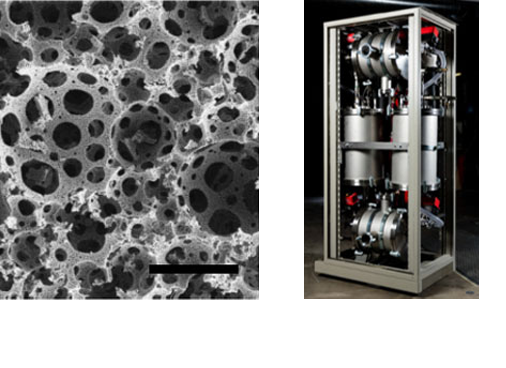Energy consumption
Heating and cooling of buildings accounts for about 20% of all energy consumed globally. Today, the vast majority of this demand is met by fossil-fuel combustion or by electrically driven heat pumps. At the same time, significant amounts of thermal energy are being wasted in industrial processes, including data centers.
Often, this waste heat cannot be utilized because its temperature is unsuitable. Therefore, there is a demand for heat conversion technologies to harness the enormous potential of wasted heat. Ideally, these technologies should have minimal electricity consumption to alleviate the burden on the electricity grid associated with daily and seasonal variations in heating and cooling demand.
“Sorption heat pumps improve the efficiency and carbon footprint of data centers and photovoltaic thermal systems.”
—IBM scientist Patrick Ruch
Key technology
A key technology for efficient heating and cooling are thermally driven sorption heat pumps. Adsorption heat pumps have the potential to utilize waste heat and renewable energy to outperform conventional heat pumps in terms of electrical efficiency and environmental impact. Successful implementation of the technology requires a targeted selection of adsorbent materials to match the temperature levels of the application, process intensification by enhancing heat and mass transfer in adsorber heat exchangers, as well as compact system design.
By converting low-grade heat into cooling by means of an adsorption refrigeration cycle, sorption heat pumps can harness waste heat from hot-water-cooled servers and provide cooling for other data center components. Owing to the low temperature (<70°C) of the waste heat, it is important to optimize the materials selection and minimize heat transfer resistances for this application. For high-concentration photovoltaic / thermal systems, sorption heat pumps can convert the recovered thermal energy to deliver valuable cooling in hot climates. Efforts in process intensification are aimed at reducing system size and cost so that future sorption-based heat pump systems can outperform compression heat pumps in these applications.

Video
NRP 70 project
![]()
Part of this work is supported by the National Research Program “Energy Turnaround” (NRP 70) of the Swiss National Science Foundation
Credit: Hochschule für Technik Rapperswil
Ask the expert
Media
Blog, IBM Research
Final results of the THRIVE project reported in November 2018.
Blog, Swiss Federal Office of Energy
(in German) On the importance of sorption heat pumps for utilizating waste heat.
Invited article, Electrosuisse and VSE Bulletin
(in German) Overview article about adsorption heat pumps and their possible application in datacenters.
Interview, IBM Systems Magazine
On the use of sorption heat pumps for heating and cooling.
Article, Tages-Anzeiger
(in German) Leading Swiss newspaper featured our research in a 2015 article.
Blog, IBM Research
On sorption heat pumps and the THRIVE project.
Publications
[1] J. Ammann, B. Michel, A.R. Studart, P.W. Ruch,
“Sorption rate enhancement in SAPO-34 zeolite by directed mass transfer channels,”
International Journal of Heat and Mass Transfer 130, 25–32 (2019).
[2] J. Ammann, B. Michel, P.W. Ruch,
“Characterization of transport limitations in SAPO-34 adsorbent coatings for adsorption heat pumps,”
International Journal of Heat and Mass Transfer 129, 18–27 (2019).
[3] S. Couck, J. Cousin Saint Remi, S. Van der Perre, G.V. Baron, C. Minas, P. Ruch, J.F.M. Denayer,
“3D-printed SAPO-34 monoliths for gas separation,”
Microporous and Mesoporous Materials 255, 185–191 (2018).
[4] J. Ammann, P. Ruch, B. Michel, A.R. Studart,
“Quantification of heat and mass transport limitations in adsorption heat exchangers: Application to the silica gel/water working pair,”
International Journal of Heat and Mass Transfer 123, 331–341 (2018).
[5] P. Ruch, J. Ammann, S. Paredes, N. Wiik, E. Lörtscher, G.I. Meijer, B. Michel,
“Sustainable data centers and energy conversion technologies,”
In Proc. 12th IEA Heat Pump Conference (2017).
[6] T. Wilde, M. Ott, A. Auweter, I. Meijer, P. Ruch, M. Hilger, S. Kuehnert, H. Huber,
“CooLMUC-2: A supercomputing cluster with heat recovery for adsorption cooling,”
In Proc. 33rd Thermal Measurement, Modeling & Management Symposium (SEMI-THERM 2017), 115–121 (2017).
[7] A.I. Radu, T. Defraeye, P. Ruch, J. Carmeliet, D. Derome,
“Insights from modeling dynamics of water sorption in spherical particles for adsorption heat pumps,”
International Journal of Heat and Mass Transfer 105, 326–337 (2017).
[8] L. Huber, P. Ruch, R. Hauert, G. Saucke, S. Kumar Matam, B. Michel, M.M. Koebel,
“Monolithic nitrogen-doped carbon as a water sorbent for high-performance adsorption cooling,”
RSC Advances 6, 25267–25278 (2016).
[9] S. Saliba, P. Ruch, W. Volksen, T.P. Magbitang, G. Dubois, B. Michel,
“Combined influence of pore size distribution and surface hydrophilicity on the water adsorption characteristics of micro- and mesoporous silica,”
Microporous and Mesoporous Materials 226, 221–228 (2016).
[10] J. Ammann, P.W. Ruch, A. Studart, B. Michel,
“Gas transport measurements in porous monolithic adsorbents,”
Poster at Sorption Friends, Milazzo, Sicily (2015).
[11] P. Ruch, S. Saliba, C.L. Ong, Y. Al-Shehri, A. Al-Rihaili, A. Al-Mogbel, B. Michel,
“Heat-Driven Adsorption Chiller Systems for Sustainable Cooling Applications,”
In Proc. 11th International Energy Agency Heat Pump Conference, Montreal, Canada (2014).
[12] A. Al-Mogbel, P. Ruch, A. Al-Rihaili, S. Al-Ajlan, P. Gantenbein, A. Witzig, B. Michel,
“The Potential of Solar Adsorption Air-Conditioning in Saudi Arabia: A Simulation Study,”
In Proc. 5th International Conference on Solar Air-Conditioning, Bad Krozingen, Germany (2013).
[13] P. Ruch, J. Ammann, I. Meijer, B. Michel,
“Aus warm mach kalt — Effizienzsteigerung in Rechenzentren mit thermisch getriebenen Wärmepumpen,”
Bulletin 6, 30–33 (2016).
